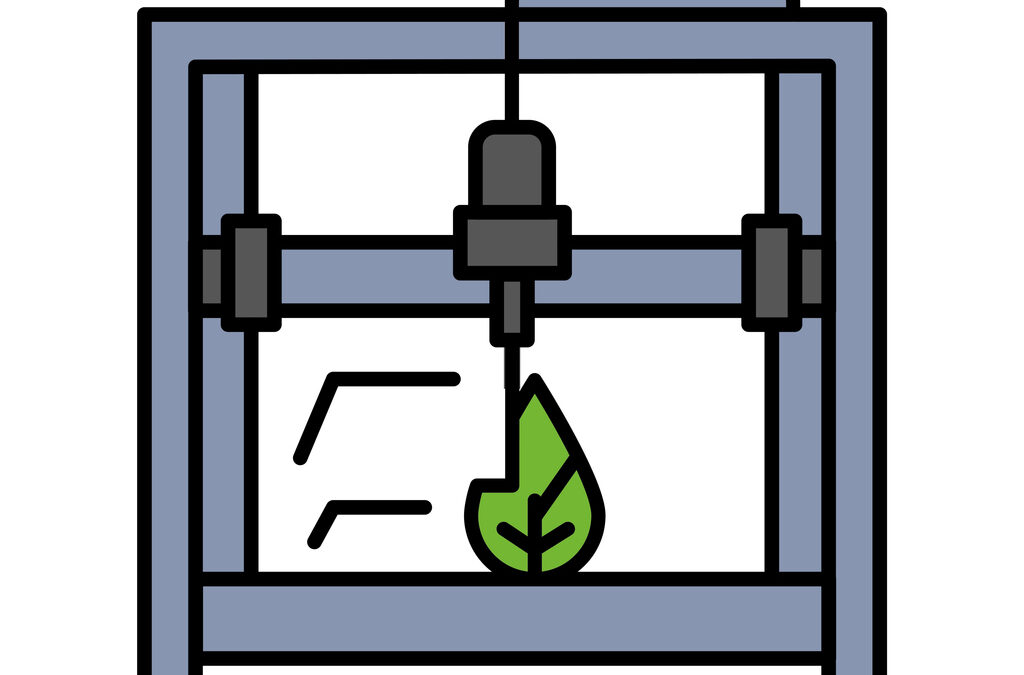Helping Industries Meet Both Production Goals and Sustainability Mandates
The manufacturing industry is undergoing a vital transformation, and at the forefront of this change is industrial 3D printing, a technology that not only revolutionizes the way products are made but also redefines what is possible in sustainable production. Gone are the days when sustainability was simply a “nice to have.” Today, it’s a non-negotiable priority, and additive manufacturing is delivering powerful solutions.
Traditional manufacturing methods, such as subtractive machining, often involve carving products out of large material blocks, resulting in excessive waste. In contrast, 3D printing builds items layer by layer, using only the material required for the final product. This precision-driven, waste-minimizing approach drastically cuts raw material usage and lowers overall carbon emissions. This blog will describe how 3D printing has proven that innovation and sustainability go hand in hand.
Material Innovation: Opening the Door to Sustainability
One area where 3D printing shines is in material sustainability. Advances in industrial-grade printers now support biodegradable polymers, recycled plastics, and even bio-based resins. This empowers manufacturers to move away from petroleum-based inputs and toward eco-friendly alternatives, without sacrificing performance. Some pioneering companies are even experimenting with metal powders derived from scrap, giving industrial waste a second life in high-precision applications.
| Material Type | Sustainable Source | Use Case |
| Biodegradable PLA | Corn starch / sugarcane | Safe educational models, prototypes |
| Recycled PETG/PLA | Post-consumer plastic waste | Eco-conscious consumer goods, art |
| Bio-Based Resins | Algae, soy, lignin | Dental, tooling, and high-detail parts |
Distributed Manufacturing: Redefining Sustainability Beyond the Factory Floor
The environmental advantages of 3D printing extend well beyond the walls of the production facility—they ripple throughout the entire supply chain. One of the most transformative aspects of additive manufacturing is its ability to enable decentralized, on-demand production. This isn’t just a shift in how we make things—it’s a shift in where and when we make them.
In traditional manufacturing, companies often mass-produce goods far in advance, requiring large inventories and centralized storage. This model leads to overproduction, excess inventory, and eventual waste, whether from product obsolescence, market shifts, or damage during storage. With 3D printing, companies can produce exactly what is needed, when it’s needed. This eliminates the need for bulk stockpiling, reduces warehousing space and energy costs, and significantly reduces the amount of unused or discarded products.
Historically, mass production has relied on standardized molds and assembly lines to churn out identical products in large quantities. While this approach has its merits in terms of efficiency and cost-effectiveness, it inherently limits the degree of customization that can be achieved. Enter 3D printing, which turns this paradigm on its head by eliminating the need for molds altogether. Instead of mass-producing identical items, 3D printers can create highly customized products on demand, opening up a world of possibilities for individualization at scale.
Localized Manufacturing Reduces Transportation Emissions
Global supply chains frequently involve shipping raw materials and finished products across continents, resulting in substantial greenhouse gas emissions. By contrast, 3D printing allows for localized manufacturing, bringing production closer to the end user. Spare parts, prototypes, tools, and even finished consumer products can be fabricated in local facilities or service bureaus, dramatically reducing the carbon footprint associated with air, sea, and ground transportation.
Digital Inventory, Physical Sustainability
Because 3D printing builds directly from digital files, manufacturers can maintain “virtual inventories” of parts instead of physical ones. Digital blueprints can be stored, shared, and activated only when production is necessary, avoiding the material and energy costs of producing and storing rarely used parts. This model promotes a circular economy mindset, characterized by reduced material consumption, extended product life cycles, and more efficient resource utilization.
Supporting Local Economies, Reducing Global Impact
By decentralizing production, 3D printing also strengthens local economies and reduces dependence on globalized manufacturing. This shift not only builds resilience against supply disruptions but also creates local job opportunities in design, engineering, and digital fabrication, spreading the environmental and economic benefits more equitably.
3D printing’s ability to support distributed, digital, and demand-driven manufacturing represents a major leap forward in sustainability. It aligns production with real-time needs, eliminates unnecessary transportation and warehousing, and empowers communities to develop local solutions. This is not just a manufacturing revolution—it’s a blueprint for a greener, smarter, and more resilient world.
Prototyping Smarter and Greener
In the product development cycle, prototyping often involves multiple iterations, tooling changes, and discarded materials. Industrial 3D printing accelerates this process while minimizing environmental impact. Designs can be tested, modified, and reprinted in hours rather than weeks, without the waste or energy demands of traditional prototyping. This not only supports innovation but also reduces landfill contributions and energy use at the ideation stage.
3D printing encourages a circular economy mindset. The ability to produce, disassemble, and even recycle components digitally is transforming the way we think about product lifecycles. With the right infrastructure, 3D-printed parts can be ground down and reused, closing the loop on what was once a linear, waste-heavy system.
By reducing waste, embracing sustainable materials, shortening supply chains, and advancing circular design, additive manufacturing is helping industries meet both production goals and sustainability mandates. As the world demands more responsible manufacturing practices, the potential of 3D printing has never been more essential—or more exciting.
At Nota3D, we partner with you as you grow with the technology, ensuring you discover every possible opportunity for 3D-printed parts to have a sustainable and innovative impact on your organization.. Visit our website to learn more.
